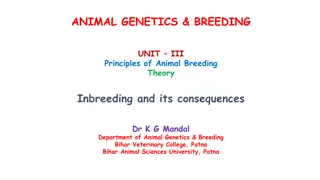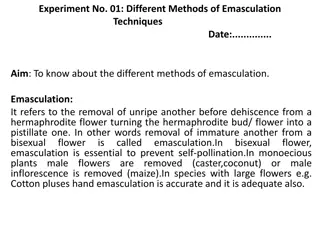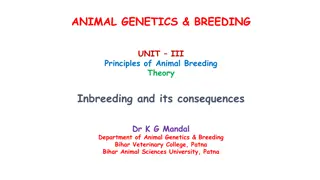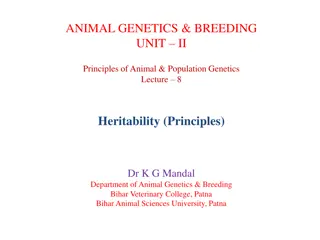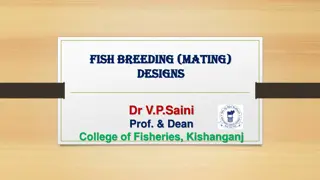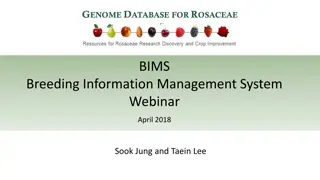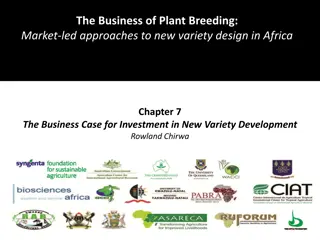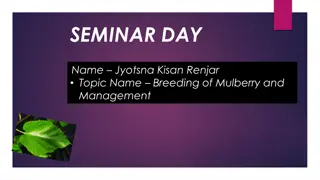Understanding Different Methods of Emasculation Techniques in Plant Breeding
Emasculation is a crucial technique in plant breeding to prevent self-pollination and prepare for controlled pollination. Various methods like hand emasculation, hot/cold water, alcohol, and more are used depending on the crop and flower size. Emasculation is key for hybridization in monoecious and dioecious plants, ensuring desired cross-pollination. Hand emasculation with forced open and clipping methods is commonly practiced, especially in crops with larger flowers. The process involves careful removal of male reproductive parts to facilitate controlled pollination.
Download Presentation

Please find below an Image/Link to download the presentation.
The content on the website is provided AS IS for your information and personal use only. It may not be sold, licensed, or shared on other websites without obtaining consent from the author. Download presentation by click this link. If you encounter any issues during the download, it is possible that the publisher has removed the file from their server.
E N D
Presentation Transcript
Practice Session Different Methods of Emasculation Techniques
Aim: To know about the different methods of emasculation Emasculation: It refers to the removal of unripe another before dehiscence from a hermaphrodite flower turning the hermaphrodite bud/ flower into a pistillate one. In other words removal of immature another from a bisexual flower is called emasculationin emasculation is essential to prevent self-pollination.ln monoecious plants male flowers are removed (caster,coconut) or male inflorescence is removed (maize). In species with large flowers e.g. Cotton, pluses hand emasculation is accurate and it is adequate also. bisexual flower, The main points related to emasculation are 1.Emasculation is relevant to bisexual (hermaphrodite) flowers only.
2. There are two main purposes of emasculation first to prevent self- pollination and second to prepare the female parent for crossing with the desired male parent. 3. In monoecious plants the male and female flowers are separate but present in the same plant/inflorescence such as in caster and maize. In caster male and female are present in the small inflorescence. In such case male flowers are removed from the inflorescence. In maize, male and female flower are in separate inflorescence in such case the male inflorescence is removed. 4. In dioecious species male and female flowers are present on the different plants such as papaya data palm etc. In such case male plants are removed.
Methods of emasculation 1) Hand emasculation (a) Forced open method (b) Clipping method 2) Emasculation with hot water. 3) Emasculation with cold water. 4) Emasculation with alcohol. 5) Suction method. 6) Chemical emasculation method. 7) Male sterility method. Hand emasculation The method is used with those crops which have relatively larger flowers such as cotton, okra,cowpea,field pea, black gram and green gram etc. It is also used in case of crops like wheat barley,triticale, rice rapeseed, mustard,brinjal,tomato,potato and several other crops.It is of two types such as
(a)Forced open method: This is the conventional method still used by the plant breeders, the is opened with the help of forceps without mutilation flowergynoecium.The exact procedure varies from crop to crop i.e. sometimes corolla may b totally removed along with epipetalous stamens e.g. gingelly.Incase of rice, the breeder is to separate the glumes with a pair of forceps in the early morning about 1-2 hours before undertaking pollination. Thus the six stamens arc removed. It is generally done between - and 6 pm are day before anthers dehisce. (b) Clipping methods: Emasculation and pollination may be facilitated however by cutting the ends of the florets. This technique is usually used in cereals like rice and wheat. In this method the top 1/3 portion of the spikelets arc cut (slant) with scissors and the anthers are removed with forceps. o corolla of the selected
2.Emasculation with hot water This method is used with those species in which flower size is very small and numbers of flowers in an inflorescence arc too many such as sorghum,paddy and certain other grasses. Usually pollen grains are more sensitive to both genetics and environment fluctuation hence, hot water kills pollen grains without causing any damage to the gynoecium. The thermo flask of appropriate size with big mouth are used for carrying hot water to the field and the whole inflorescence is immersed in the hot water for a definite time before the anther dehiscence and prior to opening of the flower which varies from species to species.The temperature of water and duration of treatment vary from crop to crop. Temperature and duration of exposure required for emasculation in some crop plants are as follow.
Table 1: Temperature and duration of hot water treatment for emasculation in different crops Name of the crop Temperature requirement( C) Duration of exposure (min.) Rice 42-44 Sorghum 47-48 Smooth broom grass 46-48 Finger millet 52 Pearl millet 45-50 5-10 10 3 2-2.5 1-10 3. Emasculation with cold water Cold water treatment like hot water kills the pollen grains without causing any damage to the gynoecium. It has been found effective in certain crops like rice and wheat for cold treatment one has to grow the plants in pots and treatment done in cooling chamber. Temperature and durationofexposurerequired foremasculation. Table2:Temperature and durationof cold watertreatment foremasculation in differentcrops Name of the crop Temperature required C Rice 0-6 Wheat 0-2 Duration of exposure (hrs.) 10-12 15-24 However, this method is lesser effective is killing pollen grains than hot water technique.
4. Alcohol treatment method It is not a commonly used method and has been tried is very few crops.This method requires special skill because immersion for longer duration may cause damage to gynoecium. Duration of treatment is very important i.e. even a slightly prolonged period of treatment more than the recommended would reduce the seed set i.e. the female reproduction organs will also be killed. Dose and duration of alcohol treatment for emasculation. Table3: Dose and duration of alcohol treatment for emasculation in different crops Name of the crop Leucern Sweet potato Dose (%) 57 55-57 Duration (sec) 10 8-10
5. Suction method It is useful in species with small flower. This method has been used in rice. Anthers are removed through suction for which suction pump is used. A thin rubber or glass tube which is attached to the suction has been used to suck the stamens from the spikelets. The desired vacuum is created to suck the anthers without causing any injury to the gynoecium. Emasculation is done just before lhr or immediately after opening of the spikelets. This method is lesser effective because considerable self-pollination, up to 10%. 6. Chemical emasculation method It is a rapid method of developing male sterile line.Emasculation is done with same chemicals. The chemicals used for induction of male sterility are known as male gametocides or chemical hybridizing agents (CHA) which selectively kills the male gamete without affecting the female gamete. Examples of some CHAs are listed as below.
1) Ethrel- Rice 2) Sodium methyl arsenate- Rice 3) Zinc methyl arsenate- Rice 4) Malic hydrazide- Cotton, Wheat,Corionder 5) FIN-50- Rice 6) Trifluro methyl sulphonamide- Maize 7) Eribberrellie acid- Corionder 8) Ethyl 4 flurooxanilate- Soyabean 9)nSurf excel- Corionder 10) Ethyloxanilots- Wheat 7. Genetic emasculation Genetic/ cytoplasmic - Genetic male sterility may be used to eliminate the process of emasculation. There is no need of emasculation where natural male sterility system operates. In general three types of male sterility operate in crop plants. a) Genetic male sterility- Every time 50% fertile plants are to be rouged out. b) Cytoplasmic genetic male sterility-This is usually preferred for commercial production of hybrid i.e. Maize, sorghum, onion, pearl millet, cotton and rice etc.
c) Cytoplasmic male sterility- Used in the crop where seed is not economic part i.e. forage crop, sugarcane and potato etc. Bagging Immediately after emasculation the flower or inflorescence is enclosed with suitable bags of appropriate size to prevent random cross pollination. Crossing Crossing refers to artificial pollination between selected genotypes etc. in order to 1. Create genetic variability in a population. 2. Combine genes from various sources such as germplasm lines wildspecies etc. 3. Develop hybrids Generally the pollen grains collected from a desired male parent should be transferred to the emasculation flower. This is normally done in the morning hours during peak anthesis. The flowers are bagged immediately after artificial crossing.
Tagging The flowers are tagged just after bagging. The tags are attached to the inflorescence or to the flower with the help of a thread containing the following information. 1. Date of emasculation (DOE) 2. Date of pollination (DOP) 3. Percentage i.e. parents involved in the crossing. 4. No. of flower emasculated. 5. Name of the breeder etc. Things to do: 1. Draw neat labelled diagrams of different emasculation methods




